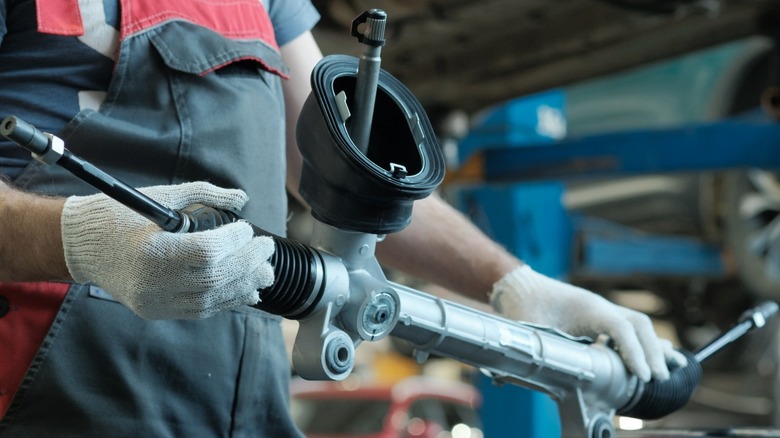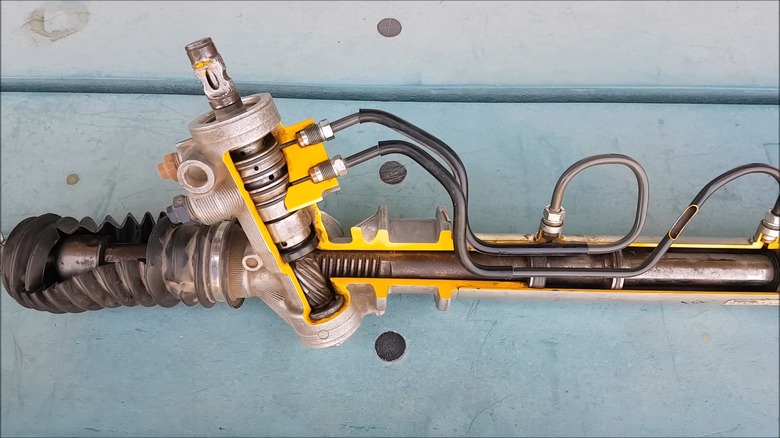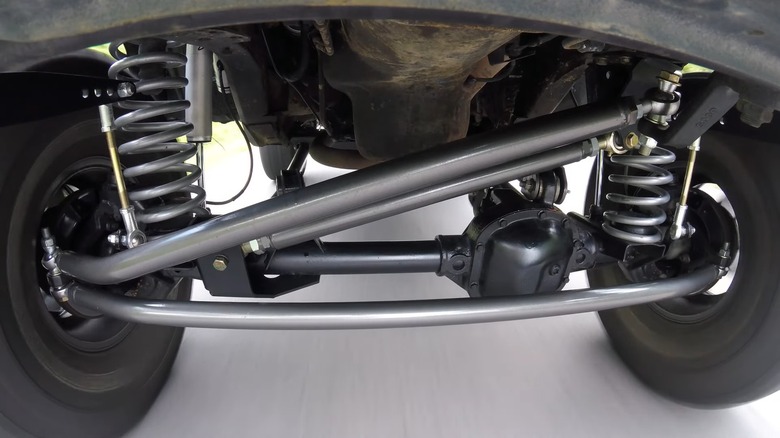Rack And Pinion Steering Vs. Power Steering: Are They The Same Thing?
If you've ever driven an older vehicle without power steering or a contemporary car with a power steering malfunction, you probably understand just how important these systems are. They drastically reduce the amount of force necessary to turn the steering wheel, making it substantially easier to maneuver your car. However, not all power steering systems are created equal or work using the same methods and power sources. Today, the two most common types of power steering systems are hydraulic power steering systems and electric power steering systems. But while these systems rely on different sources of power, they often function using similar gears and components, including the famous rack and pinion gear.
Rack and pinion steering systems — as they're sometimes called — are an extremely common type of power steering system. You can find them in both standard hydraulic and newer electric power steering systems, and unless you drive an antique car or a modern off-road vehicle like a Jeep, chances are that your vehicle has a rack and pinion gear. These components are designed to transform the rotational motion of your steering wheel into the linear movement necessary to aim the wheels of the car. Rack and pinion systems work using an ingenious and highly-complicated set of gears. They're essential parts of your car's steering and suspension systems, and they play key roles in keeping your wheels aligned and your tires in good condition. If you're interested in learning more about rack and pinion steering, stick around. As a former professional mechanic who spent years specializing in steering and suspension, I'll break it down for you. We'll explore how these parts work, and we'll compare them to some other popular types of steering systems. Let's dive in and check it out.
How does a rack and pinion gear work?
Rack and pinion steering systems work using a few key components. First, the system needs a power source. In most cases, that's either an electric motor or pressure created by hydraulic power steering fluid. Next, both hydraulic and electric rack and pinion systems rely on a steering shaft. The steering shaft or linkage is a long rod that connects to your steering wheel at one end and the steering gear or rack and pinion at the other end. Finally, the rack, pinion gear, and tie rods complete the system. Now that you know a bit more about the parts that compose a rack and pinion gear steering system, let's explain how these parts work together to steer your car.
When you turn the wheel in your car's cabin, the shaft spins, sending rotational movement down to the steering gears. The pinion gear lives at the bottom of the steering shaft and spins as you turn the wheel. Below the pinion gear is a long tube containing a rack with gear teeth. The pinion gear fits into the grooves along the rack, and as you spin the wheel inside the cabin, the pinion gear's teeth move the rack from side to side. Tie rods connect to both sides of the rack and each wheel's steering knuckle, and as the wheel turns, these rods push against the wheels to move them in either direction.
That's a basic summary of how rack and pinion gears work. There are slight differences between electric and hydraulic rack and pinion systems — for example, hydraulic pressure helps move the rack in hydraulic systems, while electric versions rely on a small motor. That said, the basic idea remains the same, and both systems rely primarily on complex gears to spin the wheels.
What are the other types of power steering systems?
We've mentioned that rack and pinion steering systems represent just one common type of power steering system that you can find in modern vehicles. We also mentioned that both hydraulic and electric power steering systems can use rack and pinion gears. Besides hydraulic and electric power steering systems, you may also encounter electro-hydraulic power steering systems. These systems combine the best of both standard hydraulic and newer electric power steering systems — they provide a traditional hydraulic feel, thanks to the preservation of a hydraulic pump and fluid lines while using an electric motor to create the hydraulic pressure. Because they rely on an electric motor instead of the car's engine, electro-hydraulic power steering systems may increase fuel mileage, and they're commonly found in commercial applications, as well as some newer cars, like the Nissan Fuga and Infiniti M.
Hydraulic, electric, and hydro-electric power steering systems represent the most common types you're likely to find on modern vehicles. However, those systems can rely on different mechanisms and parts to transfer your steering wheel's motion to the wheels. We've covered rack and pinion steering already, but now we'll briefly discuss some of the other gear systems you're likely to see. Outside of rack and pinion gears, worm gears are one of the most common types of steering gears you'll encounter. These devices encompass various kinds of steering systems, including the traditional Pitman arm setups found in older cars and trucks, as well as some modern off-road vehicles like certain Jeep models. Besides worm gear systems, other relatively common types of power steering systems include recirculating ball and RAM-type steering systems. While recirculating ball systems are usually found on off-road and heavy-duty vehicles, RAM-type systems are more commonly used in marine applications.


